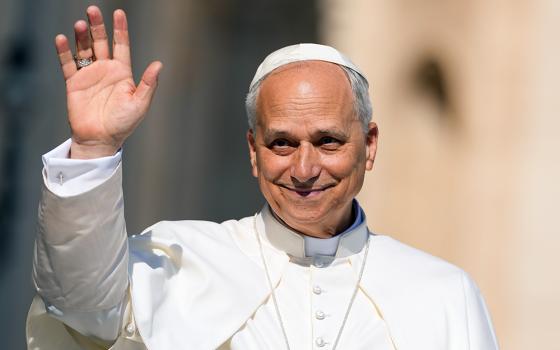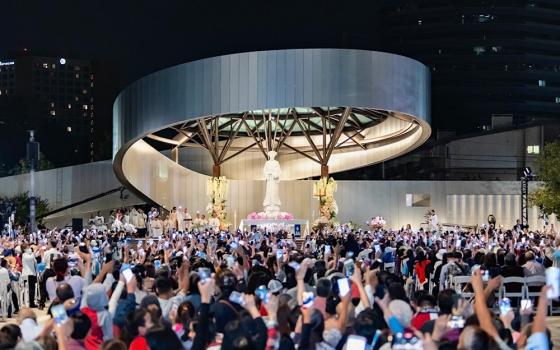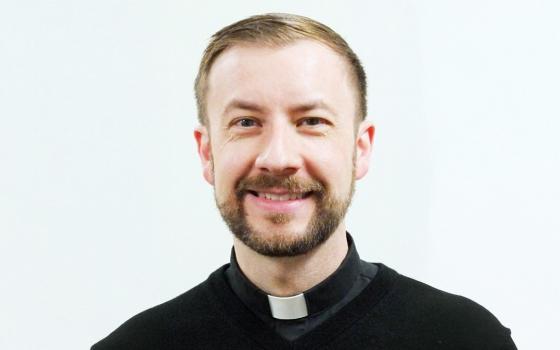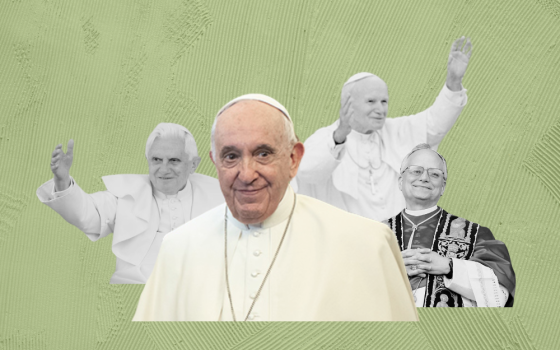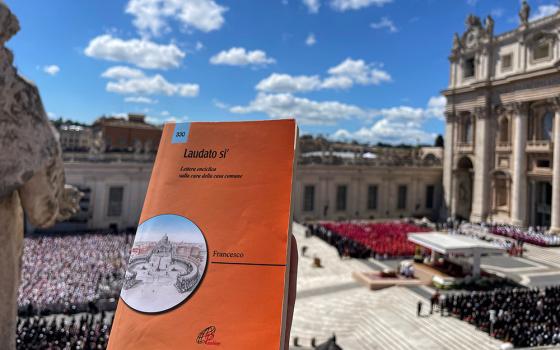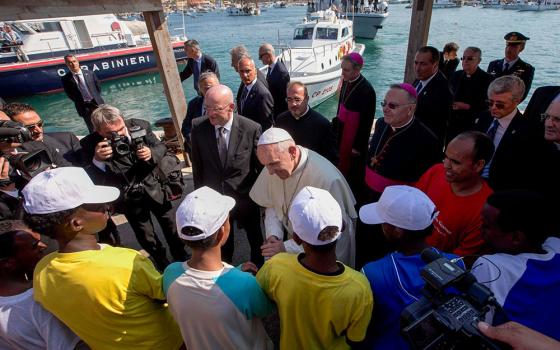Members of the Swiss Guard stand next to the coffin containing Pope Francis' body, after it was carried from his residence at Casa Santa Marta to St. Peter's Basilica at the Vatican, April 23. (OSV News/Reuters/Yara Nardi)
As the sun climbed over the colonnades of St. Peter's Square this morning, a somber but resolute crowd gathered in growing numbers, stretching far beyond the marble balustrades and cobblestones. After a brief procession, the body of Pope Francis, who died Monday, lies in state in St. Peter's Basilica. Pilgrims, students and the faithful from Rome and across the globe came to pay their respects.
The eight-hour line began forming well before dawn April 23, winding its way through the square and along the Via della Conciliazione. The formal procession into the basilica started shortly after 9 a.m. local time, when the doors opened to the public. The route led directly through the main nave of the basilica, where Pope Francis' body rests in the sanctuary beneath the soaring dome designed by Michelangelo. The crowd's pace was deliberate, quiet. The mood, reverent.
"It's not every day you get an opportunity to pay respects to the pope," said Jack Albright, an American student who is in Rome for an exchange program at John Cabot University. "I had a lot of free time today between classes, and so made it a mission to get out here."
The pontiff's mortal remains, in an open wooden coffin, were carried from Casa Santa Marta, the Vatican guest house where lived for 12 years after his election in 2013.

The procession with Pope Francis' body, who will lie in state at St. Peter's Basilica for three days, passes through the crowd at the Vatican, Wednesday, April 23. (AP/Gregorio Borgia)
The coffin will remain at St. Peter's Basilica until his funeral at 10 a.m. Saturday. The basilica will remain open on Wednesday and Thursday evening until midnight to allow the faithful to pay their respects. The public mourning period will end at 7 p.m. Friday.
According to informal estimates from the Italian security service in St. Peter's Square, about 100,000 people remained in the square about 5:30 p.m. Given the turnout, a Vatican press office official said, officials may leave the basilica's doors open beyond midnight.
Francis will be buried in the papal basilica of Santa Maria Maggiore. He is to be the first pope to be interred outside the Vatican in more than a century.
The bells of St. Peter's tolled as Francis' coffin was escorted by a procession of 80 cardinals, bishops, pastors from about 50 Rome parishes, close friends and relatives of Francis, priests and nuns resident in the Vatican, and Swiss Guards. Six sediari pontifici — laymen who, among other Vatican duties, organize St. Peter's Square events — walked along each side of the coffin.

Mourners pray at Pope Francis' coffin inside St. Peter's Basilica April 23. Among them, kneeling, are Cardinal Matteo Zuppi, president of the Italian conference of bishops and archbishop of Bologna, and Archbishop Giuseppe Baturi of Cagliari, Italy. (NCR photo/Camillo Barone)
The pope's body traversed the same route path the pope had traveled via popemobile a few days earlier as he greeted the enthusiastic throngs gathered in St. Peter's Square on Easter Sunday.
Temperatures hovered near 24°C (75°F), and the midday sun beat down on the crowd with unwavering intensity. Some fanned themselves with folded pamphlets, others sipped from water bottles. Despite the heat, there was little complaint. Pilgrims stood shoulder to shoulder, many clasping rosaries, some in quiet prayer. Others wept, wiping away tears as they neared the entrance to the basilica. Hymns occasionally broke out, hushed voices carried softly across the square.
"His message that resonated with me the most was his message for overall peace amongst all the nations, and for his outreach to the poor," said Morghan Mansfield, a 20-year-old from the Diocese of Monterey, currently studying in Rome. "I decided to come here today to honor our beloved father, who has passed on."

An hourslong procession of mourners filled St. Peter's Basilica April 23 to pay respects to Pope Francis, who died April 21. Vatican officials had planned to keep the basilica's doors open until midnight for mourners to pay their respects, but said they might extend that to accommodate the crowd. (NCR photo/Camillo Barone)
Pope Francis, the first Jesuit and first Latin American pope, championed a vision of a more inclusive church. His papacy emphasized humility, environmental responsibility and compassion for the marginalized. That message reverberated beyond the church.
Aaron Brandt, an American Jewish student in Rome, traveled to St. Peter's Square to pay tribute to Francis' broad influence. "I think the biggest sort of parallel between Judaism and Pope Francis is the idea of tolerance," he said. "There's a lot of social justice within Judaism, and it kind of draws some similarities with Pope Francis, because he was more of a progressive pope."
"I just like the way he ran things, as head of church," Brandt said. "He just wanted to show that he was there for peace."
Pope Francis' body is carried in a coffin into Saint Peter's Basilica, on the day of its transfer, at the Vatican, April 23. (OSV News/Reuters/Dylan Martinez)
Inside the basilica, mourners moved silently past the pontiff's body, many pausing to cross themselves or bow their heads. No chatter. Just a shared, sacred silence, interrupted only by flashes from photographers.
For Kevin Richardson, a British Catholic who caught a last-minute flight to Rome from Manchester, the pilgrimage was both a spiritual duty and a deeply personal farewell.
"If you have the time and money, I think you are sort of obliged to come," he said. "I liked when the piazza was completely empty during the COVID period, and he came out with the Eucharist just over there. That was a good scene."
Some mourners, like Mary Itaas from Cebu, Philippines, found themselves in Rome to pay respects to the pope by providence. "We just came here to enter the Holy Door," she said. "It was a big surprise for us and very, very sad to read the pope is already passed away."
The National Catholic Reporter's Rome Bureau is made possible in part by the generosity of Joan and Bob McGrath.
Advertisement

